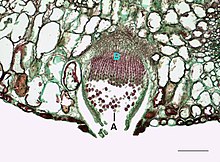Reproductive structure of a fungus

Aeciospores are one of several different types of spores formed by rusts. They each have two nuclei and are typically seen in chain-like formations in the aecium.
References
- Kyu Lee, Seung; Kakishima, Makoto (April 1999). "Aeciospore surface structures of Gymnosporangium and Roestelia (Uredinales)". Mycoscience. 40 (2): 109–120. doi:10.1007/BF02464289. ISSN 1340-3540. S2CID 84953707.
- Bueno-Sancho, Vanessa; Orton, Elizabeth S.; Gerrity, Morgan; Lewis, Clare M.; Davey, Phoebe; Findlay, Kim C.; Barclay, Elaine; Robinson, Phil; Morris, Richard J.; Blyth, Mark; Saunders, Diane G.O. (22 October 2021). "Aeciospore ejection in the rust pathogen Puccinia graminis is driven by moisture ingress". Communications Biology. 4 (1): 1216. doi:10.1038/s42003-021-02747-1. ISSN 2399-3642. PMC 8536709. PMID 34686772.
- "Glossary: Aeciospore". Pacific Northwest Pest Management Handbooks. Pacific Northwest Extension. 11 April 2019. Retrieved 23 March 2023.
This mycology-related article is a stub. You can help Misplaced Pages by expanding it. |